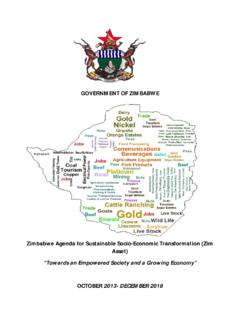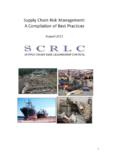Transcription of ITIL Version 3.0 (V.3) Service Transition Guidelines
1 ITIL Version ( ) Service Transition Guidelines By Braun Tacon Executive Summary: This document is seven pages. Page one is informational/background only. What follows over the next six pages are the three principles of Service Transition which are fundamental to the delivery of Services that brings Business Value. By using this document as a checklist to ensure the identification of key requirements and to assess if those requirements are being met, we can help our Service Providers Transition Services to Nike that delivers Business Value. Additionally by using a common set of criteria and measurement we can baseline where we currently stand and measure progress in a consistent and relevant way from both a tower and program point of view, with a goal of managing to our commitments and deliverables.
2 Finally, since Change is the focus of Service Transition , Change is the focus of this document. Pages four and five are entirely devoted to the topic of Change and Change Management.. ITIL V. 3 is a framework for Service Management that is built around five separate lifecycle phases: Service Strategy, Service Design, Service Transition , Service Operation, and Continual Service Improvement. In ITIL. V. 3 a Service is defined as, a means of delivering value to customers by facilitating the outcomes those customers want to achieve without the ownership of specific costs and risks.
3 Previously, we have been engaged in the Service Strategy phase. Service Strategy activities are: Define the market Develop the offerings Develop Strategic Assets Prepare for execution Next came the Service Design phase. Please review this document for a fuller understanding of Service Design. Once Service Design is complete, the next phase is Service Transition . The core activities of Service Transition are: Plan and manage the capacity and resources required to package, build, test, and deploy a release ( Service ) into production Provide a consistent and rigorous framework for evaluating the Service capability and risk profile Establish and maintain the integrity of all identified Service Assets and configurations Provide good-quality knowledge and information Provide efficient and repeatable build and installation mechanisms Core focus.
4 Ensure that the Service can be managed, operated, and supported according to the requirements and constraints specified within Service Design The three major aspects of Service Transition are: Change Management (CM), Service Asset and Configuration Management (SACM), and Release and Deployment Management (RDM). Each of these principles is essential to effective Service Transition and each has a specific set of requirements and measures. Since CM is the most complex of these three topics, we will spend a bit more time discussing those concepts. This is not to say the other aspects are less important but since good CM will be a key dependency to our success during Transition , it is also good practice to focus there.
5 Before discussing the three aspects of Service Transition here are some general concepts and definitions that you should be familiar with: Change A Change to an existing Service or the introduction of a new Service including: addition, modification, removal, documentation, etc. From a CM perspective, all Service Change should be authorized and planned Change Advisory Board (CAB) A body that exists to support the authorization of Changes and to assist CM in the assessment and prioritization of the Changes Change History Information about all changes made to a Configuration Item during its life.
6 Change History consists of all those Change Records that apply to the CI. Change Management The Process responsible for controlling the Lifecycle of all Changes. The primary objective of Change Management is to enable beneficial Changes to be made, with minimum disruption to IT Services. Change Model A repeatable way of dealing with a particular Category of Change. A Change Model defines specific pre-defined steps that will be followed for a Change of this Category. Change Models may be very simple, with no requirement for approval ( Password Reset) or may be very complex with many steps that require approval ( major software Release).
7 See Standard Change, Change Advisory Board. Change Record A Record containing the details of a Change. Each Change Record documents the Lifecycle of a single Change. A Change Record is created for every Request for Change that is received, even those that are subsequently rejected. Change Records should reference the Configuration Items that are affected by the Change. Change Records are stored in the Configuration Management System. Change Request Synonym for Request for Change. Change Schedule A Document that lists all approved Changes and their planned implementation dates.
8 A Change Schedule is sometimes called a Forward Schedule of Change, even though it also contains information about Changes that have already been implemented. Change Types Changes are categorized into: o Standard Change A pre-approved Change that is low Risk, relatively common and follows a Procedure or Work Instruction. For example password reset or provision of standard equipment to a new employee. RFCs are not required to implement a Standard Change, and they are logged and tracked using a different mechanism, such as a Service Request. See Change Model. o Normal Change One raised by a request from the initiator (the individual or organizational group that requires the Change).
9 O Emergency Change A Change that must be introduced as soon as possible. For example to resolve a Major Incident or implement a Security patch. The Change Management Process will normally have a specific Procedure for handling Emergency Changes. See Emergency Change Advisory Board (ECAB). Change Window A regular, agreed time when Changes or Releases may be implemented with minimal impact on Services. Change Windows are usually documented in SLAs. Configuration Item (CI) Any Component that needs to be managed in order to deliver an IT Service . Information about each CI is recorded in a Configuration Record within the Configuration Management System and is maintained throughout its Lifecycle by Configuration Management.
10 CIs are under the control of Change Management. CIs typically include IT Services, hardware, software, buildings, people, and formal documentation such as Process documentation and SLAs. Configuration Management The Process responsible for maintaining information about Configuration Items required to deliver an IT Service , including their Relationships. This information is managed throughout the Lifecycle of the CI. Configuration Management is part of an overall Service Asset and Configuration Management Process. Configuration Management Database (CMDB) The CMDB is a database used to store Configuration Records throughout their Lifecycle.


